
Major General Sir Alexander Cunningham was a British Army engineer with the Bengal Engineer Group who later took an interest in the history and archaeology of India. In 1861, he was appointed to the newly created position of archaeological surveyor to the government of India; and he founded and organised what later became the Archaeological Survey of India.
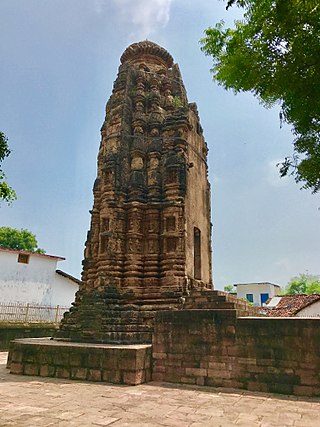
Arang, also known as "The town of temples" of Chhattisgarh, is a block and a Nagar Palika in Raipur District in the state of Chhattisgarh, India. It is situated near the eastern limits of Raipur City and close to Mahasamund City. Arang is an ancient town, which was ruled by the Haihayas Rajput dynasty. It is famous for its many Jain and Hindu temples which belong to the 11th and 12th centuries; these are the Mand Deval Jain temple, the Mahamaya temple, the Panchmukhi temple and the Hanuman temple. Due to the Archaeological finds of a copper plate inscription dated to the Gupta Empire, known as the Arang Plate of Bhimasena II of the clan of Rajarsitulya, has established the town's ancient history as a Hindu and Jain religious centre, which was then under the rule of Hindu kings. The Mand Deval Jain temple is the most ancient of these temples dated to the 11th century where three huge images of Digambara tirthankaras are deified in the sanctum sanctorum; these are carved in black stone and polished.
Bahuriband, near Katni in Madhya Pradesh, is a famous inscription at the feet of a colossal stone image of Jain Tirthankara Shantinath. The colossal statue is 12 ft 2 in (3.71 m) in height.
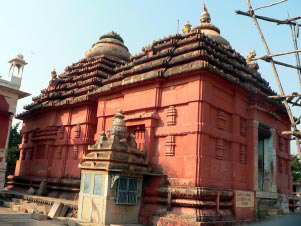
Digambara Jaina Temple is a Jain temple in Bhubaneswar, in the state of Odisha, India. The temple is on the top of Khandagiri hill. This hill is honeycombed with a series of rock-cut Jaina caves, commissioned by King Kharavela in the 1st century BCE. The rock-cut caves are protected by Archaeological Survey of India. The enshrining deities are a series of Jaina tirthankara images.
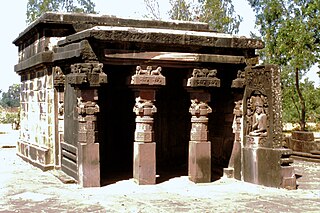
Tigawa is a village in Indian state of Madhya Pradesh and an archaeological site with a complex of about 36 Hindu temple ruins. Of these, the small but important and ancient Kankali Devi Temple is in good condition, and is usually dated to about 400-425 CE. Unless another building is mentioned, references to "the temple" below refer to this.

Jain art refers to religious works of art associated with Jainism. Even though Jainism has spread only in some parts of India, it has made a significant contribution to Indian art and architecture.

Kankali Tila is a mound located at Mathura in the Indian state of Uttar Pradesh. The name of the mound is derived from a modern temple of Hindu goddess Kankali. The famous Jain stupa was excavated here in 1890-91 by Alois Anton Führer.
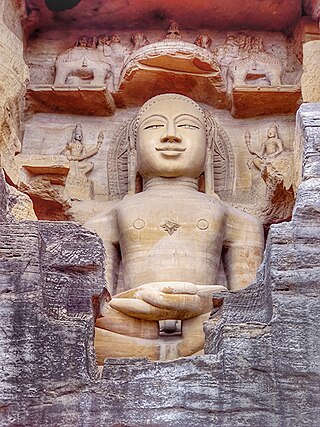
The Gopachal rock-cut Jain monuments, also called Gopachal Parvat Jaina monuments, are a group of Jain rock-cut carvings dated to between the 7th and 15th centuries. They are located around the walls of the Gwalior Fort, Madhya Pradesh. They depict Tirthankaras in seated Padmasana posture as well as standing Kayotsarga posture, in the typical naked form of Jain iconography.

Jain hoysala complex in Halebidu, Hassan district consists of three Jain Basadis dedicated to the Jain Tirthankars Parshvanatha, Shantinatha and Adinatha. The complex is situated near Kedareshwara temple and Dwarasamudra lake. The temple complex also includes a step well called Hulikere Kalyani.

Arang Jain temples is group of three Jain temples in Arang, Raipur, Chhattisgarh, India. These temples dates back to the 9th and 11th centuries.

The Lakshana Devi Temple in Bharmour is a post-Gupta era Hindu temple in Himachal Pradesh dedicated to Durga in her Mahishasura-mardini form. It is dated to the second half of the 7th-century, and is in part one of the oldest surviving wooden temples in India.
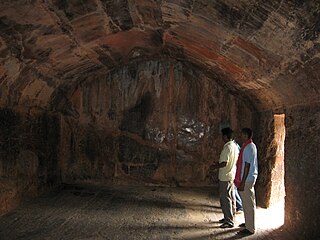
The Son Bhandar Caves are two man-made caves carved into the base of the Vaibhar Hills in Rajgir in the state of Bihar in India. Based on the dedicatory inscription found in the largest cave — which uses Gupta script of the 4th century CE — the caves are generally dated to the 3rd or 4th century CE, although some authors have suggested the caves could actually go back to the period of the Maurya Empire, possibly as early as 319 BCE. The main cave is rectangular with a trapezoidal entrance and a vaulted ceiling, reminiscent of the structure of the earlier Barabar Caves. The quality of the polish and the finish are nevertheless much inferior to that of the Barabar Caves. The stone of Son Bhandar is also much less hard than the granite of the Barabar caves, and therefore did not require the same degree of effort and technique.

Vidisha is considered to be Puranakshetras Jain tirtha. The Jain temples are located in Vidisha district in state of Madhya Pradesh, India. According to Jain belief, Vidisha is the birthplace of Shitalanatha, the tenth tirthankar. Here the first 108 feet elevated temple with all Tirthankaras with Shitalanatha as the principal deity is under construction.

Maladevi Temple is a Jain temple located in Gyaraspur town of Vidisha in state of Madhya Pradesh, India.

Bajramath Temple is a Jain temple located in Gyaraspur town of Vidisha in state of Madhya Pradesh, India.
Panchasara Parshwanath temple is a Jain temple located in Patan, Gujarat. The temple was constructed in 8th century during the reign of Vanaraja Chavda of Chavda dynasty.

Gadarmal Devi temple is a Hindu and Jain temple at Badoh village of Vidisha, Madhya Pradesh. Also called Gadarmal Temple of the Mothers, it is one of India's yogini temples. It has 42 niches for yogini statues, unusually arranged in a rectangle; it must originally have been hypaethral.

The Ahichchhatra Jain temples is a group of Jain temples in Ahichchhatra village in Aonla tehsil of Bareilly district in Uttar Pradesh, North India. Ahichchhatra is believed to be the place where Parshvanatha, the 23rd Tirthankar of Jainism, attained Kevala Jnana.

Kahaum pillar is an 8 m structure located in Khukhundoo in the state of Uttar Pradesh. The pillar was erected in the 5th century during the reign of Skandagupta. The pillar has carvings of Parshvanatha and other tirthankars with Brahmi script.

Chaturmukha Basadi is a symmetrical Jain temple located in Gerusoppa in Honnavar Taluk of Uttara Kannada district in the Indian state of Karnataka. The temple is situated near the banks of the Sharavati.


















